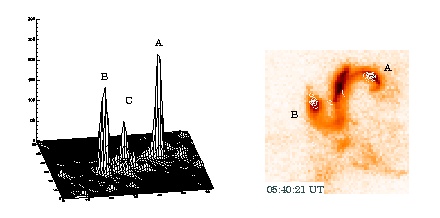
(Morimoto, Ph.D. thesis, Rikkyo Univ., 1996.)

The 27-October-1991 flare is the most energetic flare observed by Yohkoh during the last solar cycle. The left panel shows the intensity of hard X-ray sources in the impulsive phase, and right, soft X-ray image with hard X-ray source (contours) superposed.

This panel shows independent hard X-ray light curves from sources A and B, identified in the images as the extreme footpoints of the flaring loops. Contrary to typical behavior in compact loop flares, the footpoints A and B have independent and only partially correlated variability. The lowest trace shows the total flux in the 4-7 MeV energy band dominated by inelastic-scattering gamma-ray lines such as C_12 4.41 MeV. This emission also shows a different time profile but appears to match - with a time lag - the correlated component of the A, B emission after the gamma-ray onset. This evidence suggests strongly that the main particle acceleration both ions and electrons, took place on closed magnetic loops spanning the entire flare region.